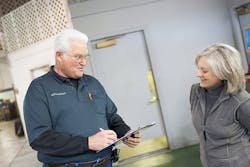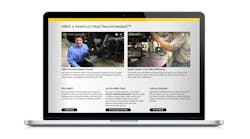During the past four years, Bill Park can point to many numbers he’s proud of. His business, Big Sky Auto Body, founded in 1994, has expanded from one shop in Tucson, Ariz., to three other locations in Tucson and Phoenix, for a total of 58,000 square feet. Despite the economic downturn, he’s still processing 425 cars per month, and earning $10 million in annual revenues. But the number he gets most excited about is his repeat and referral business, which has increased by 60 percent during the past two years.
To get these kind of results, Big Sky Auto Body had to change its approach to customer service. Like many auto body shop owners, Park thought his customer satisfaction index (CSI) scores were pretty good. Customers reported they were happy with their repairs. But those numbers weren’t translating into repeat or referral business. That changed when he met Steve Schoolcraft, president of auto body marketing firm Phoenix Solutions Group, which has overhauled CSI measurement based on a two-year research program that found little connection between indicated repeat or referral on a survey and actual repeat and referral business.
“Every body shop believes their repeat rate is phenomenal, when in fact it’s less than 5 percent,” Schoolcraft asserts. “The industry is measuring what customers should do, based on their logical responses. But the emotional side is what drives referral. If that customer has an emotional connection with you, they are 70 percent more likely to refer you.” Over time, that relationship, properly handled, translates to profit, sales and organic growth that are 3.1 times greater than the average shop.
Emotional Sway
Park was intrigued, yet skeptical. “It just sounded too easy,” he says. What was a so-called emotional connection, and how could it really make a difference to his bottom line? Weren’t efficiency measures for cycle time—Park’s is 6.4 days—and accurately determining scope of repair most important?
It’s not that those things aren’t important, Schoolcraft says, but the emotional side—long proven to be a powerful motivator in where people spend—has too long been neglected by most body shops. “The problem is we’ve been taught to just process a customer,” Schoolcraft says. “And when a shop does get a repeat or referral, if they do nothing to reward that customer, they’re hampering that opportunity to mold that customer into a selling machine.” In effect, they’re spending more to make new customers instead of making more from those they already have.
The good news about the emotional aspects that shops tend to miss out on? They can be addressed with simple fixes: “Customers will tell you flat out what they want: more communication, the car to be delivered clean, and someone to review the repair,” Schoolcraft says. “Those shops that listen and do that do fine. But most ignore that.”
Measuring What Customers Want
A traditional customer survey for collision shops asks about 10 questions, such as, “How did you learn about us?” “How satisfied were you with the repair?” and “Would you recommend this shop to family or friends?” These surveys don’t dig deeply enough into the customer service experience to deliver much value, Schoolcraft says. “The only time they are useful is when a customer answers, ‘No,”” he says. “Then it’s clear something needs to be addressed.” A customer may give a shop positive ratings, but never return or refer others. Why? Because your survey didn’t ask about things like a late delivery date, or how well your insurance or rental car partner delivered.
Based on its research, Phoenix Solutions Group beefed up its customer survey, which is mailed after a repair, to 29 questions. Nine are devoted to uncovering more details about how a customer found a shop and whether or not the customer would refer the shop. (For instance, it asks how far away a customer lives from the shop, how many other shops the customer looked at first, and whether an insurance agent or claim representative recommended the shop.) At its heart, the survey tracks customer satisfaction and engagement at four levels: security, procedural fairness, distributional fairness and interactional fairness.
The survey also tracks customer engagement at four levels. A “disengaged” customer fills out and returns a survey with negative marks and/or comments. An “unengaged” or neutral customer—by far the bulk of any shop’s customer base—doesn’t return the survey, or they return one with no additional written comments. An “engaged” customer fills out the survey with mostly positive marks and comments indicating missteps. And a “fully engaged” customer returns a survey with a 100 percent score and written comments.
Over time, shops should expect about a 55 percent return rate for this new survey, and the number of fully engaged customers should rise. According to Phoenix Solutions Group’s research, if a shop converts 30 percent of its customer base to fully engaged, it will enjoy repeat and referral rates at least 20 percent higher than average.
The Audit
A shop that works with Phoenix Solutions Group completes an audit of 90 to 120 days to find out from these new surveys where it stands with its customers. Phoenix Solutions Group gives a shop the tools to track in more detail which relationships or circumstances are driving their repeat and referral business. Big Sky Auto Body, for example, uses a customer database to track “the hows and the whos,” Park says, of which agent, DRP or other relationship brought a customer in the door. If this customer fills out a survey after the repair, those details are added, too. Based on this more fine-grained customer focus, it’s up to shops to redo business processes in ways that make sense for them.
The 90-day audit of Big Sky Auto Body was revealing. Despite the shop always being “in the top tier on CSI,” the audit indicated customer complaints revolved around poor communication—they thought the car would come back cleaner than it did. They were promised one delivery date, and got another. Nobody at the shop was reviewing the repair with them. Repeated or referred business went unacknowledged. And in some surveys, customers said a certain employee should not be interacting with them. “It showed us that we were focusing more on the car than on the person,” Park says.
To address these customer concerns required a cultural shift for employees, one that Park estimates took the better part of the first year. Analyzing the survey results and role-playing with his employees helped them see the body shop experience as if they themselves were the customer, and brainstorm ways to better engage with them. For example, to encourage accountability, each shop technicians now signs a window hanger—which is labeled with the customer’s name—as the car moves through the shop.
You Had Me at ‘Hello’
Up front, Park says, Big Sky Auto Body now spends twice as much time welcoming a customer, listening to him or her, and establishing trust. Customers sit down with a retention specialist to go over a claim, damage, method of payment, time frame, whether they’ve had a prior repair and how that experience went. “We talk about the customer, their needs, and try to get a clear understanding of their mind-set,” Park says.
If a customer repeats business or provides a referral, Big Sky Auto Body mails a gift, such as a gas card or movie voucher. Now two years into the audit, Park’s shops see a survey return rate between 52 and 55 percent, and its number of fully engaged customers has grown from 8 percent to an average of 21.7 percent for his four locations.
Happier Employees
The customer-first emphasis has also changed the employee culture at his shops. Prior to working with Phoenix Solutions Group, employees were defensive about negative customer feedback. “The first thing someone would do is try to defend what happened, instead of being honest and trying to learn from it,” Park says. “It would always be, ‘Oh, it’s one of those customers.’” Now the approach is one of creative problem solving. “They love to review our scores and analyze the misfires, and ask, ‘Where did we fail and how can we fix it?’”


